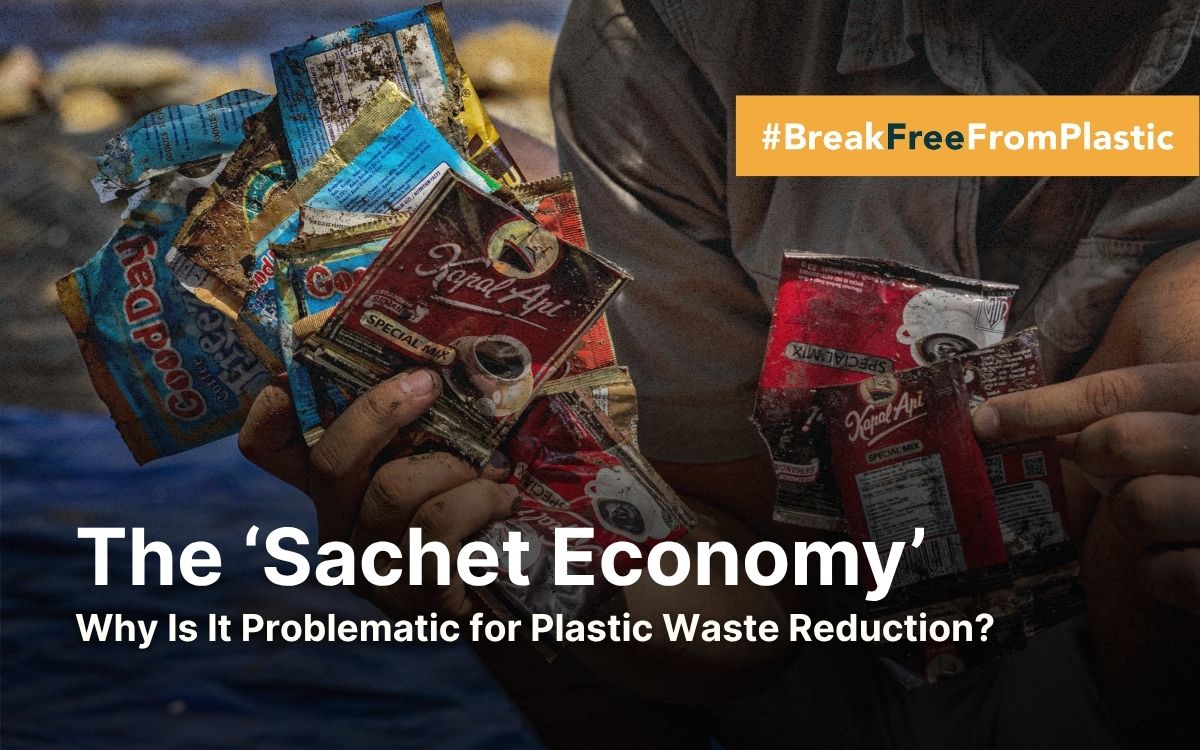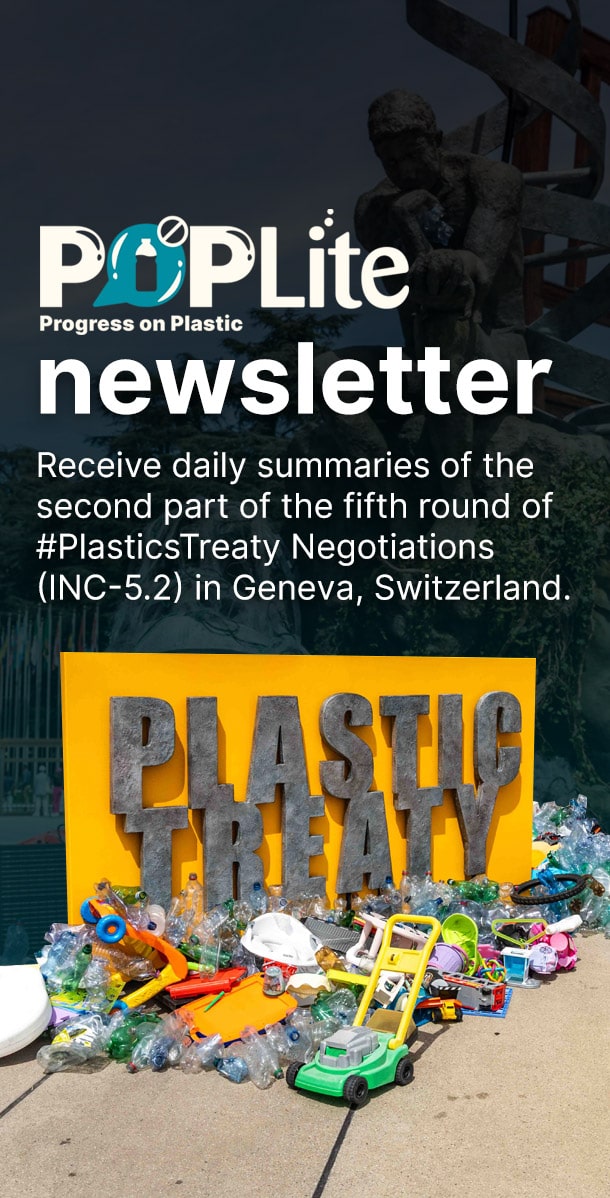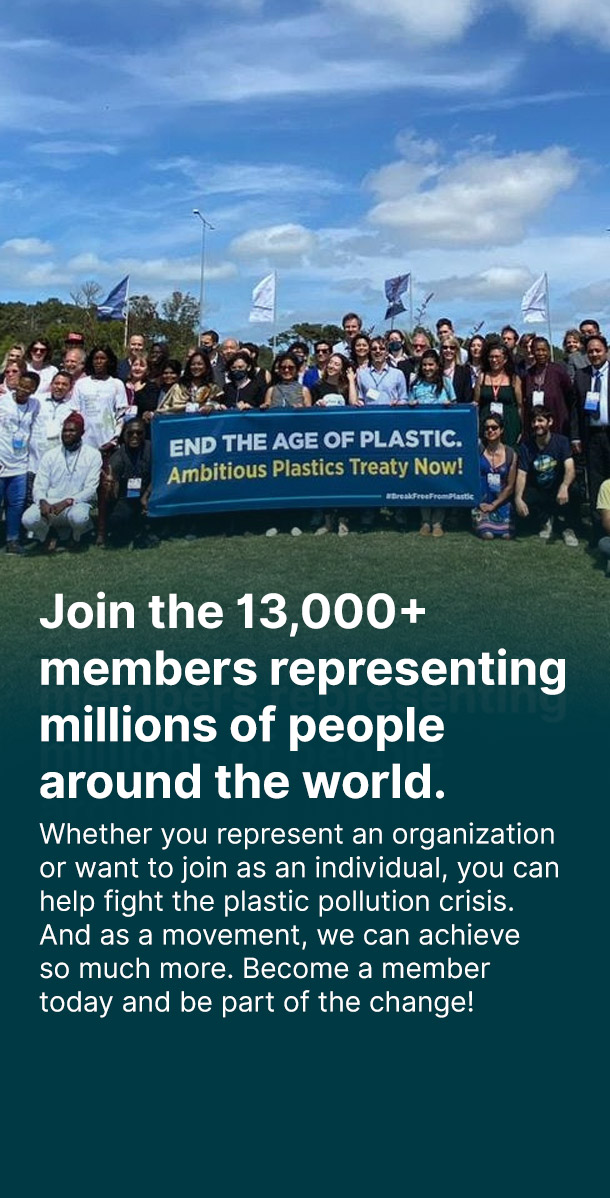This small, flexible plastic pouch was designed to package products like shampoo, instant coffee, laundry detergent, and potato chips in affordable quantities — just enough for a day’s consumption. For companies, sachets are a go-to packaging solution for reaching consumers who can’t afford to buy in bulk.
On the surface, they seem like a practical, convenient solution to economic restraints. But experts are increasingly sounding the alarm over what’s now known as the “sachet economy” and the massive environmental trade-offs that come as a direct result of widespread sachet use.
And the troubling reality is that sachets really did not meet an actual need. Instead, their sudden rise largely displaced existing low-waste, sustainable practices that communities had long embraced before multinational corporations flooded markets with sachet-packed goods.
In this article, we’ll unpack how the sachet economy took root, especially in the Global South, and why it now represents one of the most urgent challenges in the fight against plastic pollution.
What Are Sachets For? Understanding Their Implications for the Global South
In the Philippines alone, sachets make up 52% of residual plastic waste. This, in itself, is more than just a statistic. Rather, it’s a reflection of how deeply sachets have saturated daily life, while also overwhelming waste management systems that were never designed to handle such an influx of disposable plastic.
What makes this even more ironic and unfortunate is that many communities, like those in the Philippines, already had sustainable consumption patterns in place. For instance, the Filipino tradition of “tingi” or buying in small quantities has predated the arrival of sachets. Townsfolk used glass bottles and jars when purchasing essentials like fish sauce, vinegar, and oil, effectively operating their own refill and reuse systems.
Corporations reframed these cultural practices into a profit-driven model of disposability. By the 1990s, sachets were aggressively marketed as affordable options for low-income households. Reusable containers and local refill systems were slowly replaced by single-use packaging.
Today, over 855 billion sachets are discarded globally. The highest usage is among the poorest communities — and this reveals more about the influence of global supply chains that prioritize profit over sustainability than it does about individual consumer choices.
Understanding what sachets are and how they’ve evolved means asking a harder question: How can we now reduce plastic waste without simply replacing one harmful system with another?
Profit at the High Cost of Health and Environmental Damage
Brand audits across Asia consistently identify Unilever, Procter & Gamble, and Nestlé as top sachet polluters. These companies often position their products as responses to poverty, but the benefits largely flow back to them — not the communities they claim to serve.
The dominant narrative these companies peddle ignores a critical truth: that they created much of the demand they now claim to fulfill, conveniently shifting the blame for plastic waste onto consumers.
While sachets have expanded market reach and boosted profits for multinational corporations, they’ve also offloaded gargantuan environmental and health consequences on the most vulnerable populations.
Sachets are nearly impossible to recycle due to their multilayer composition, leaving municipalities with few disposal options. Local governments, which are typically underfunded and overwhelmed, resort to unsustainable practices like incineration or landfilling.
Bearing the brunt of this practice are waste pickers, who recover up to 60% of post-consumer plastic, working without protective equipment as they handle non-recyclable sachets that clog equipment or must be burned, exposing themselves to toxins. In extreme cases, sachets are burned as fuel in cement kilns or tofu factories, releasing dioxins linked to cancer and respiratory illness.
Meanwhile, communities located near plastic production sites — so-called “sacrifice zones” — unwittingly suffer chronic exposure to these harmful emissions. In areas where sachets are burned as fuel, residents are exposed to air pollution linked to cancer, respiratory illness, and birth defects.
The environmental toll continues after disposal — sachets clog drains and waterways, contribute to flooding, and break down into microplastics that contaminate food, water, and even human organs.
What may look like a cheap product is actually a costly legacy of systemic inequality and environmental neglect. That sachets bring convenience is a myth. What remains true is the mounting waste and the ecological and physical harm that comes with it.
Without understanding how to reduce plastic waste through producer accountability and stricter regulation, sachets will continue to undermine both public health and the planet.
Pushing for Corporate Accountability
If corporations created the problem, can they be part of the solution? Top multinational corporations have publicly committed to sustainability, yet sachets remain entrenched in their business models.
Unilever, for example, pledged to make all plastic packaging reusable, recyclable, or compostable by 2030 for rigid plastics and by 2035 for flexible plastics. But even its own executives have admitted sachets are practically unrecyclable. Former chief executive officer Alan Jope called them packaging that has “no real value.”
Despite this, Unilever continues to produce hundreds of thousands of tonnes of plastic annually, with sachets making up a significant share. Chemical recycling projects and waste-to-energy schemes like CreaSolv have failed to deliver meaningful results. Similarly, the so-called “plastic neutrality” pledge from Unilever and other corporations, which stated that they’d collect and process more plastic waste than they use in their packaging, seems to be devised to intentionally shift attention away from the core issue: the overproduction of plastics.
A five-year, worldwide brand audit published in 2024 revealed that a good half of all plastic items polluting the environment bore brands, with the top five companies —The Coca-Cola Company, PepsiCo, Nestlé, Danone, and Altria credited for 24% of the branded plastic retrieved. Despite this, it's the local governments, not these companies, that carry the financial burden. In fact, according to the World Bank, local governments in low-income countries tend to spend up to 20% of their annual municipal budgets on solid waste management.
Extended Producer Responsibility (EPR) policies aim to shift this cost back onto companies. But current efforts often focus too narrowly on downstream fixes like collection and co-incineration, while not giving ample attention to upstream measures like product redesign or sachet reduction.
Without robust, well-established mandates, EPR will just remain a half-measure — never fully realized. To achieve true accountability, we need corporations to internalize the real costs of the sachets they produce — and governments to enforce policies prioritizing waste reduction over surface-level recovery. Any conversation about how to make sachets more sustainable must begin with questioning their necessity in the first place.
Moving Towards Sustainable Alternatives
Real solutions are emerging, but they don't come from the plastic producers. While many companies are experimenting with biodegradable sachets, this merely substitutes one disposable material for another. The real opportunity lies in reviving refill and reuse systems that once flourished in many communities. These solutions, which have sustained generations before sachets were even invented, can eliminate waste at the source and encourage low-waste living right at the grassroots.
The role of citizen advocacy should also be recognized. Brand audits, often organized as community-led campaigns, expose which corporations are behind the plastic waste crisis, empower the public to demand regulatory action.
Throughout these campaigns, government action remains critical. In addition to binding EPR laws, reforms must support refill-based enterprises, protect informal waste workers, and update packaging regulations to phase out sachets entirely and shift the burden of responsibility.
A sachet-free future can offer much more than environmental gains. It also holds the potential for creating new jobs, cleaner cities, and more resilient economies — and the key to this is not swapping materials, but transforming the systems we currently have to better benefit the layman. The goal is not to find better wrappers, but to stop wrapping everything in waste.
Across Asia, this transformation is already underway, thanks to grassroots solutions.
In the Philippines, over 300 local governments have implemented regulations targeting single-use plastics. Cities like Quezon City and San Fernando have gone a step further, expanding their bans to include sachets and other disposable packaging. For instance, Quezon City’s ordinance prohibits the use of sachets in dine-in establishments — underscoring how local policies can potentially drive meaningful change in communities.
In Negros Island, the Wala Usik initiative supports Zero Waste sari-sari stores across eight cities, replacing sachets with micro-refill systems. In just seven months, these stores prevented over 45,000 plastic items from polluting the environment, proving that pro-poor alternatives are not only feasible but also highly effective.
In Vietnam, the Zero Waste Alliance has introduced reuse models in over 100 schools and communities, supported by the country’s 2020 Law on Environmental Protection and a 2035 Circular Economy roadmap.
Likewise, Indonesia and India are piloting refillable packaging systems and launching startup accelerators to scale reuse models within the food and beverage sectors. These alternatives to sachets also help teach communities how to reduce plastic waste at the source.
The progress from these case studies offers hope for a post-sachet future — but the road ahead remains steep. Many projects stall without consistent funding, and informal workers are often underprotected. Despite growing calls for stronger corporate accountability, EPR policies remain weak or poorly enforced.
Still, these stories remind us that the most fruitful innovations are built from the ground up, fueled by community resilience and supportive local governance.
It’s Time to Trade Sachets for Sustainability
Though often marketed as tools for economic inclusion, sachets have entrenched a cycle of waste and inequality. The burden of their convenience falls heaviest on communities least equipped to handle the consequences.
Sachets now stand as a symptom — of inequality, of overproduction, and of a throwaway system disguised as convenience. And for this reason alone, this crisis demands systemic accountability above all else.
Corporations must be held responsible for the waste they produce — and not just through abstract measures peppered with loopholes and vaguely worded pledges, but through concrete, enforceable policies that confront the root issue: plastic overproduction.
What we need is a coordinated effort to phase out sachets and scale pro-poor, community-centered solutions rooted in reuse and refill systems.
As we reflect on what sachets are and how to make sachets less harmful, we must also think ahead and build realistic alternatives — systems that truly serve both people and the planet. Learn more about the story of sachets and how we can dismantle the myth of sachet-driven sustainability by visiting this page.




